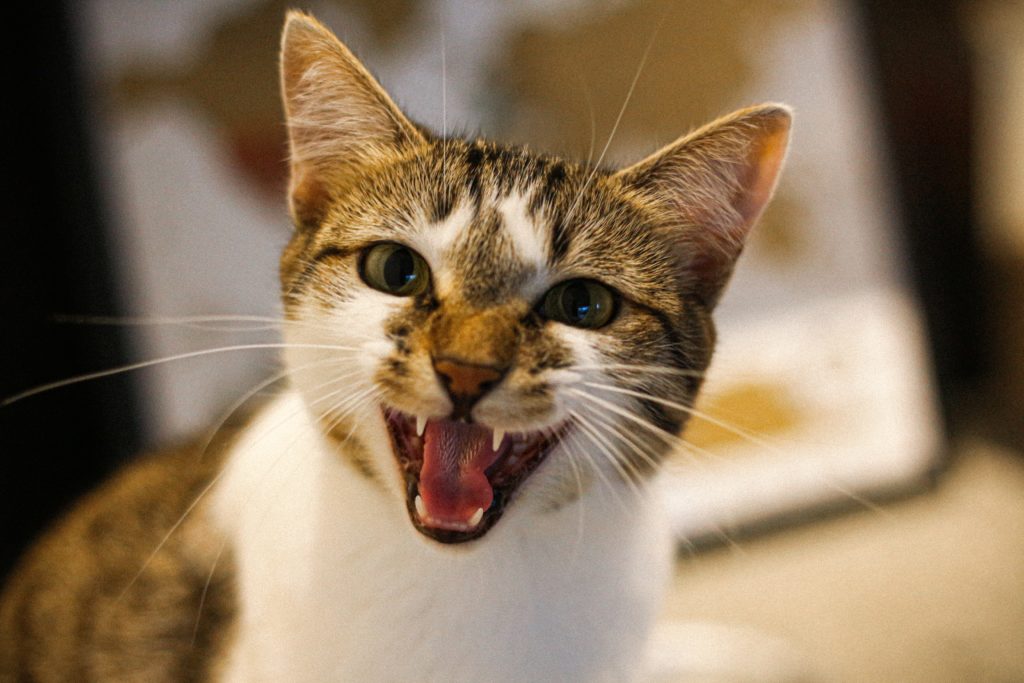Grooming is an essential part of caring for your cat. It helps keep their fur clean, shiny, and healthy, prevents mats and tangles, reduces shedding and hairballs, and improves their comfort and well-being. However, grooming can also be a challenge if you have an aggressive cat. Aggressive cats may not tolerate being handled or brushed, and may react with fear, anger, or overstimulation when groomed by humans or other cats. They may bite, scratch, hiss, or run away when you try to groom them.
So how can you groom an aggressive cat without getting hurt or stressing them out? In this article, we will share some tips and techniques for grooming aggressive cats safely and effectively. We will also explain the common causes and signs of aggression in cats, the safety precautions you need to take while grooming them, and the steps you need to follow to groom them properly.
By following these tips and techniques, you will be able to keep your cat’s fur in good condition and build trust and bond with them through grooming.
Understanding Aggressive Cats
Before you attempt to groom an aggressive cat, you need to understand why they are behaving that way. Aggression in cats can have different causes and triggers, such as:
- Pain or discomfort: Cats may become aggressive when they are in pain or discomfort due to injury, illness, arthritis, dental problems, or skin conditions. They may associate grooming with pain and try to avoid it or lash out at it.
- Fear or anxiety: Cats may become aggressive when they are afraid or anxious due to unfamiliar situations, loud noises, strangers, other animals, or past trauma. They may perceive grooming as a threat and try to escape or defend themselves.
- Overstimulation: Cats may become aggressive when they are overstimulated by too much petting, brushing, or touching. They may reach a point where they can’t handle any more stimulation and try to stop it by biting or scratching.
- Dominance or territoriality: Cats may become aggressive when they are trying to assert their dominance or protect their territory from other cats or humans. They may groom other cats as a way of communication, redirection, or control. They may also resist being groomed by humans as a way of showing who’s the boss.
To identify the cause of aggression in your cat, you need to observe their body language and behavior. Some signs of aggression in cats include:
- Dilated pupils
- Flattened ears
- Arched back
- Raised fur
- Tail flicking
- Growling
- Hissing
- Swatting
- Biting
- Scratching
If you notice any of these signs in your cat while grooming them, you need to stop immediately and give them some space. You also need to take some safety precautions while grooming them to avoid getting injured or making them more upset.
Safety Precautions While Grooming Aggressive Cats
Grooming an aggressive cat can be risky for both you and your cat. You need to take some safety precautions while grooming them to protect yourself from bites and scratches and prevent your cat from hurting themselves or damaging your furniture. Some safety precautions you need to take while grooming an aggressive cat are:
- Wear gloves: Gloves can protect your hands from bites and scratches and also reduce the sensation of touch for your cat. You can use leather gloves or rubber gloves for this purpose.
- Use a towel: A towel can help you wrap your cat gently and securely while grooming them. This can prevent them from squirming or escaping and also calm them down by creating a sense of security. You can use a large bath towel or a special cat grooming bag for this purpose.
- Use a muzzle: A muzzle can help you prevent your cat from biting you while grooming them. This can be useful for cats who are very aggressive or fearful of grooming. You can use a soft nylon muzzle or a basket muzzle for this purpose.
- Use a carrier: A carrier can help you transport your cat safely and comfortably to and from the grooming area. This can prevent them from running away or hiding and also reduce their stress by providing a familiar and cozy space. You can use a hard-sided carrier or a soft-sided carrier for this purpose.
- Use a helper: A helper can help you hold your cat still and gently while grooming them. This can make the grooming process easier and faster and also provide some reassurance and distraction for your cat. You can ask a friend, a family member, or a professional groomer for this purpose.
By taking these safety precautions, you will be able to groom your aggressive cat with less risk and more confidence. However, you also need to follow some tips and techniques to make the grooming experience more pleasant and positive for your cat.
Tips and Techniques for Grooming Aggressive Cats
Grooming an aggressive cat can be challenging, but not impossible. You need to follow some tips and techniques to make the grooming experience more pleasant and positive for your cat. Some tips and techniques for grooming aggressive cats are:
- Create a calm grooming environment: You need to choose a quiet, comfortable, and familiar place for grooming your cat. You need to avoid any distractions, such as loud noises, bright lights, other pets, or children. You also need to make sure that the temperature is not too hot or cold for your cat.
- Gradual desensitization and positive reinforcement: You need to introduce grooming to your cat gradually and gently. You need to start with short and easy sessions, focusing on one area at a time. You need to praise and reward your cat with treats, toys, or affection when they allow you to groom them. You need to avoid forcing or punishing your cat for resisting or reacting negatively to grooming.
- Use specialized grooming tools and techniques: You need to use the right grooming tools and techniques for your cat’s fur type, length, and condition. You need to use a soft-bristled or rubbery brush or a pin brush for short-haired cats, a slicker brush or a comb for long-haired cats, and a mat splitter or a scissors for matted cats. You need to brush your cat gently and carefully, following the direction of their fur growth. You need to avoid pulling or tugging on their fur or skin.
- Seek professional help when needed: If you are unable to groom your aggressive cat on your own, you may need to seek professional help from a veterinarian or a groomer. They may be able to sedate your cat or use special equipment or techniques to groom them safely and effectively. However, you should only resort to this option as a last resort, as it may be stressful and expensive for you and your cat.
By following these tips and techniques, you will be able to groom your aggressive cat more successfully and smoothly. However, you also need to follow some steps to groom them properly.
Step-by-Step Guide to Grooming Aggressive Cats
Grooming an aggressive cat can be done in six steps:
- Preparing the grooming area: You need to prepare the grooming area by setting up the tools, the towel, the carrier, and the treats. You also need to put on your gloves and muzzle your cat if necessary.
- Calming the cat before grooming: You need to calm your cat before grooming by petting them gently, talking to them softly, or playing with them briefly. You also need to wrap them in the towel or put them in the carrier if necessary.
- Introducing grooming tools slowly: You need to introduce grooming tools slowly by letting your cat sniff and rub their face against them. You also need to start with the least threatening tool, such as a rubbery brush or a grooming mitt.
- Gentle handling and restraint techniques: You need to handle and restrain your cat gently while grooming them by holding them firmly but not tightly, supporting their head and body, avoiding their eyes and ears, and using the towel or the helper if necessary.
- Addressing specific grooming needs: You need to address specific grooming needs by brushing their fur thoroughly, trimming their nails carefully, cleaning their ears gently, wiping their eyes softly, and checking their teeth regularly.
- Monitoring the cat’s stress levels and taking breaks if necessary: You need to monitor your cat’s stress levels while grooming them by watching their body language and behavior. You also need to take breaks if necessary by stopping the grooming session, giving them some space, or rewarding them with treats.
By following these steps, you will be able to groom your aggressive cat properly and thoroughly. However, you may also encounter some challenges and difficulties along the way.
Dealing with Challenges and Difficulties
Grooming an aggressive cat can be difficult at times. You may face some challenges and difficulties while grooming them, such as:
- Handling aggressive reactions during grooming: If your cat reacts aggressively during grooming by biting, scratching, hissing, or growling at you, you need to stop immediately and give them some space. You also
- Dealing with fear-based aggression: If your cat is aggressive due to fear or anxiety, you need to reassure them and make them feel safe and comfortable. You also need to avoid any triggers that may scare them, such as loud noises, sudden movements, or unfamiliar objects.
- Techniques for managing grooming-related stress: If your cat is stressed by grooming, you need to help them relax and cope with it. You can use some techniques such as calming music, aromatherapy.
Conclusion
Grooming is an important part of caring for your cat, but it can also be a challenge if you have an aggressive cat. Aggressive cats may not like being groomed and may react with fear, anger, or overstimulation when groomed by humans or other cats. However, you can groom an aggressive cat safely and effectively by following some tips and techniques, such as:
- Understanding the causes and signs of aggression in cats
- Taking safety precautions while grooming them
- Creating a calm grooming environment
- Gradual desensitization and positive reinforcement
- Using specialized grooming tools and techniques
- Seeking professional help when needed
- Following a step-by-step guide to grooming them
- Dealing with challenges and difficulties
- Following some additional tips and considerations
By following these tips and techniques, you will be able to keep your cat’s fur in good condition and build trust and bond with them through grooming. You will also be able to enjoy the benefits of grooming your cat, such as improving their health, comfort, and well-being.
We hope you found this article helpful and informative. And if you are looking for more tips and advice on how to care for your cat, please check out our other articles on our website.
With a passion for cats and years of experience in cat care and grooming, I have gained valuable insights and expertise that I want to share with other cat lovers. I believe that every cat deserves the best care possible, and through this platform, I aim to empower cat owners like you to provide the utmost love and care for your feline companions.



